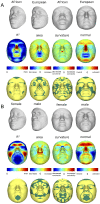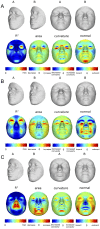Modeling 3D facial shape from DNA
- PMID: 24651127
- PMCID: PMC3961191
- DOI: 10.1371/journal.pgen.1004224
Modeling 3D facial shape from DNA
Abstract
Human facial diversity is substantial, complex, and largely scientifically unexplained. We used spatially dense quasi-landmarks to measure face shape in population samples with mixed West African and European ancestry from three locations (United States, Brazil, and Cape Verde). Using bootstrapped response-based imputation modeling (BRIM), we uncover the relationships between facial variation and the effects of sex, genomic ancestry, and a subset of craniofacial candidate genes. The facial effects of these variables are summarized as response-based imputed predictor (RIP) variables, which are validated using self-reported sex, genomic ancestry, and observer-based facial ratings (femininity and proportional ancestry) and judgments (sex and population group). By jointly modeling sex, genomic ancestry, and genotype, the independent effects of particular alleles on facial features can be uncovered. Results on a set of 20 genes showing significant effects on facial features provide support for this approach as a novel means to identify genes affecting normal-range facial features and for approximating the appearance of a face from genetic markers.
Conflict of interest statement
The authors have declared that no competing interests exist.
Figures






Comment in
-
Let's face it--complex traits are just not that simple.PLoS Genet. 2014 Nov 6;10(11):e1004724. doi: 10.1371/journal.pgen.1004724. eCollection 2014 Nov. PLoS Genet. 2014. PMID: 25375250 Free PMC article. No abstract available.
-
Establishing a multidisciplinary context for modeling 3D facial shape from DNA.PLoS Genet. 2014 Nov 6;10(11):e1004725. doi: 10.1371/journal.pgen.1004725. eCollection 2014 Nov. PLoS Genet. 2014. PMID: 25375363 Free PMC article. No abstract available.
References
-
- Carlson DS (2005) Theories of craniofacial growth in the postgenomic era. Seminars in Orthodontics 11: 172–183.
-
- Sperber GH (2001) Craniofacial development. (Decker Inc., Ontario, B.C.).
-
- Williams SE, Slice DE (2010) Regional shape change in adult facial bone curvature with age. American Journal of Physical Anthropology 143: 437–447. - PubMed
-
- Coussens AK, van Daal A (2005) Linkage disequilibrium analysis identifies an FGFR1 haplotype-tag SNP associated with normal variation in craniofacial shape. Genomics 85: 563–573. - PubMed
Publication types
MeSH terms
Substances
Grants and funding
LinkOut - more resources
Full Text Sources
Other Literature Sources
Miscellaneous

